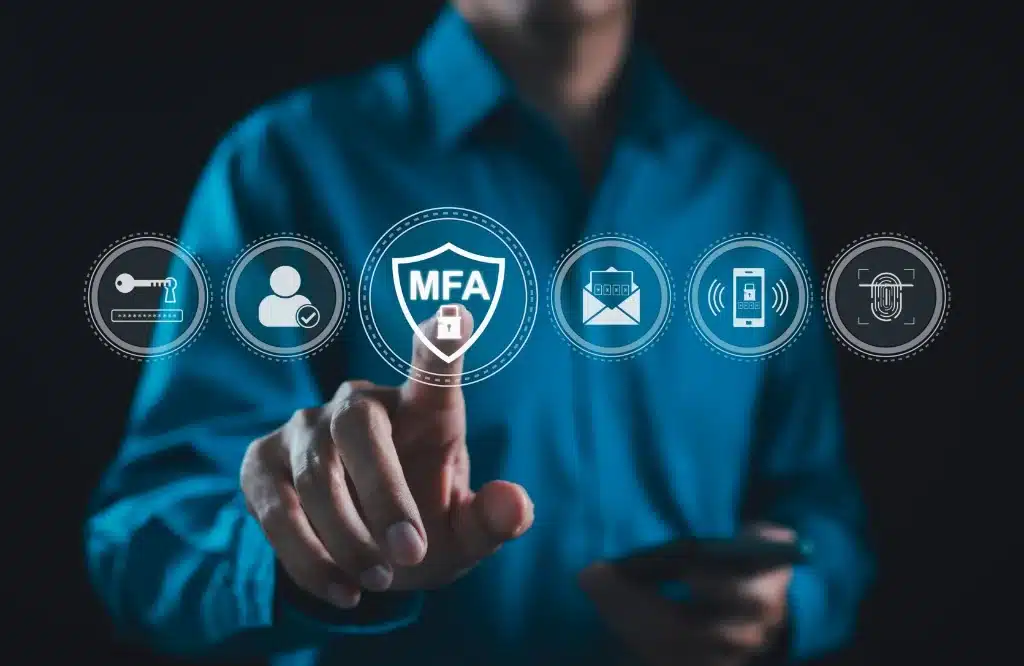
October is Cybersecurity Awareness Month, which is a timely reminder for businesses to evaluate and strengthen their defenses. Cyberattacks are growing more sophisticated each year, and small and medium-sized businesses (SMBs) continue to be prime targets. Many of these attacks succeed not because companies lack technology, but because they rely too heavily on a single line of defense: passwords.
Why passwords alone aren’t enough
Passwords are an important line of defense, but far from foolproof. Cybercriminals have countless ways to steal or crack them, including:
- Phishing attacks: Cybercriminals send deceptive emails that appear to come from trusted sources such as Microsoft, a bank, or a business partner. These messages trick employees into entering their credentials on fake login pages, handing passwords directly to cybercriminals.
- Credential stuffing: After a breach at one company, cybercriminals take the stolen emails and passwords and use automated tools to “stuff” them into other platforms, hoping that users have reused the same credentials across accounts.
- Brute force attacks: Cybercriminals use sophisticated programs capable of guessing millions of password combinations in seconds.
No matter how strong your password is, it’s still only one barrier. Once that barrier falls, your accounts are exposed. The good news is that a simple yet highly effective safeguard can stop most of these attacks before they start: multifactor authentication (MFA).
What is multifactor authentication, and how does it work?
MFA is a security method that adds extra steps to verify your identity before granting access to an account or a system. Instead of relying solely on a password, MFA requires at least two distinct factors from the following categories:
- Something you know: A password, PIN, or security question
- Something you have: A one-time passcode sent to your phone, an app-generated code, or a physical security key
- Something you are: Biometric identifiers such as fingerprints, facial recognition, or voice patterns
When MFA is enabled, logging in to your online account becomes a two-step process. First, you need to enter your password (something you know). Then, you’ll be asked for another form of verification, such as a code sent via text message (something you have) or a fingerprint scan (something you are). Account access is granted only after successfully completing both steps. This means that even if a cybercriminal obtains your password, they still need the second verification factor, making MFA one of the easiest and most effective ways to block unauthorized access.
Choosing the right MFA solution for your business
Not all MFA methods are created equal. Picking the right one for your business involves weighing your organization’s needs, security requirements, and budget.
The most common MFA options include:
SMS- or email-based MFA
This MFA solution works by sending a temporary code to a user’s phone or email. It’s affordable and relatively simple to implement, making it a good starting point for businesses with limited budgets. However, SIM swapping attacks can bypass this method, so businesses should consider supplementing it with additional security measures as their needs grow.
App-based authenticators
Applications such as Microsoft Authenticator or Google Authenticator provide stronger protection over SMS-based codes. They generate secure, time-sensitive codes locally on a user’s device. The initial setup requires more effort, but the increased security makes it worthwhile for most businesses.
Hardware tokens
For organizations managing highly sensitive data, physical security keys provide one of the highest levels of protection. These devices require a physical presence for login, making remote attacks extremely difficult to execute successfully. However, distributing and managing hardware tokens across large or remote teams can be challenging.
Biometric MFA
Leveraging fingerprint or facial recognition offers a powerful combination of strong security and user convenience. Biometric technology is increasingly integrated into modern laptops and smartphones, making it a highly effective and accessible option.
Integrating MFA into your cybersecurity strategy
MFA works best as part of a broader, layered defense strategy. At SpectrumWise, it forms a key part of our 7 Layers of Security framework, which is a comprehensive approach designed to protect every part of your IT environment:
- Information security policies: Clear, documented guidelines establish how data is handled, accessed, and protected.
- Physical security: Protecting your technology starts with physical safeguards, from locked server racks and controlled office access to password-protected screensavers and secure workstations.
- Secure networks and systems: We design and maintain your IT infrastructure with advanced protection in place from day one. Firewalls, encryption, and continuous network monitoring keep your systems running safely and smoothly.
- Vulnerability programs: Regularly updated antivirus software, firewalls, and security patches close potential entry points before cybercriminals can exploit them.
- Access control measures: MFA, role-based permissions, and complex passwords prevent unauthorized users from accessing sensitive information.
- Data protection and backup: Reliable backup systems and proactive data monitoring safeguard your most valuable information. If a disruption occurs, you can recover your data with minimal downtime.
- System monitoring and testing: Continuous monitoring helps detect unusual activity early, while routine security testing identifies and fixes vulnerabilities before they can cause harm.
Together, these seven layers form a strong, resilient defense system that keeps your business secure, compliant, and productive.
Fortify your cyber defenses with SpectrumWise
Protecting your SMB doesn’t require a massive IT budget, just a smart, strategic approach.
SpectrumWise can help you integrate MFA and other key security measures into a complete defense plan built around your business needs. Get in touch with us to take the first step toward a stronger, more secure IT environment.
